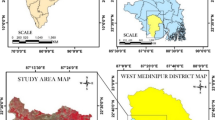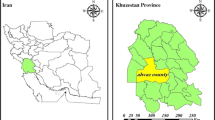Abstract
Increasing human desire for urbanization and, as a result, urban growth and development has caused the replacement of natural objects such as vegetation and mountains with building structures and roads. This exacerbates the phenomenon of urban heat islands (UHI), one of the main threats to the quality of human life. In this research, a post-classification change detection algorithm is proposed based on UHI classification maps are generated using multi-temporal Landsat images from a rapidly developing urban area, in Iran in 17-years’ time interval. The main research objective is to investigate the effects of constructing new built-up areas on urban heat islands considering the land surface temperature, vegetation coverage, and surface object types. The production of UHI classification maps is based on the probabilistic reasoning rules for integrating the LST, Albedo, and NDVI as lines of evidence considering land use/land cover (LU/LC) object types. The analysis of the UHI change detection results in the rapidly developing urban area in this research indicates that the area percentage of built-up object class has increased by 12.1% in 17 years. This amount of construction led to a 23.7% increase in the high UHI class, which is equivalent to 2931 hectares. Moreover, the regions with medium and low UHI have decreased by − 16.09 and − 9.12%, respectively, which indicates an increase in the intensities of urban heat islands during this period.









Similar content being viewed by others
References
Anniballe, R., Bonafoni, S., & Pichierri, M. (2014). Spatial and temporal trends of the surface and air heat island over Milan using MODIS data. Remote Sensing of Environment, 150, 163–171.
Bonafoni, S., Baldinelli, G., & Verducci, P. (2017). Sustainable strategies for smart cities: Analysis of the town development effect on surface urban heat island through remote sensing methodologies. Sustainable Cities and Society Journal, 29, 211–218.
Chen, S. H., Wang, W., & Liang, H. (2019). Evaluating the effectiveness of fusing remote sensing images with significantly different spatial resolutions for thematic map production. Physics and Chemistry of the Earth, Parts a/b/c., 110, 71–80. https://doi.org/10.1016/j.pce.2018.09.002
Dai, Z., Guldmann, J. M., & Hu, Y. (2018). Spatial regression models of park and land-use impacts on the urban heat island in central Beijing. Science of the Total Environment, 626, 1136–1147.
Jin, M. L., & Dickinson, R. E. (2010). Land surface skin temperature climatology: Benefitting from the strengths of satellite observations. Environmental Research Letters., 5, 1–13. https://doi.org/10.1088/1748-9326/5/4/044004
Kamali Maskooni, E., Hashemi, H., Berndtsson, R., Daneshkar, P., & Kazemi, M. (2021). Impact of spatiotemporal land-sue and land-cover changes on surface urban heat islands in a semiarid region using Landsat data. International Journal of Digital Earth., 14(2), 250–270.
Kumar, K. S., Udaya Bhaskar, P., & Padmakumar, K. (2012). Estimation of land surface temperature to study urban heat island effect using Landsat ETM+ image. International Journal of Engineering Science and Technology, 4(2), 771–778.
Li, H., Zhou, Y., Li, X., Meng, L., Wang, X., Wu, Sh., & Sodoudi, S. (2018). A new method to quantify surface urban heat island intensity. Science of the Total Environment, 624(15), 262–272. https://doi.org/10.1016/j.scitotenv.2017.11.360
Liu, P., Jia, Sh., Han, R., Liu, Y., Lu, X., Zhang, H (2020) RS and GIS supported urban LULC and UHI change simulation and assessment. Journal of Sensors. https://doi.org/10.1155/2020/5863164.
Luan, X., Yu, Z., Zhang, Y., Wei, Sh., Miao, X. (2020). Remote sensing and social sensing data reveal scale-dependent and system-specific strengths of urban heat island determinants. Journal of Remote Sensing. https://doi.org/10.3390/rs12030391.
Mirzaei, M., Verrelst, J., Arbabi, M., Shaklabadi, Z., & Lotfizadeh, M. (2020). Urban heat island monitoring and impacts on citizen’s general health status in Isfahan Metropolis: A remote sensing and field survey approach. Journal of Remote Sensing. https://doi.org/10.3390/rs12081350
Onishi, A., Cao, X., Ito, T., Shi, F., & Imura, H. (2010). Evaluating the potential for urban heat-island mitigation by greening parking lots. Urban Forestry & Urban Greening, 9(4), 323–332.
Polydoros, A., Mavrakou, T., & Cartalis, C. (2018). quantifying the trends in land surface temperature and surface urban heat island intensity in mediterranean cities in view of smart urbanization. Journal of Urban Science. https://doi.org/10.3390/urbansci2010016
Pramanik, S., & Punia, M. (2020). Land use/land cover change and surface urban heat island intensity: Source–sink landscape-based study in Delhi, India. Environment, Development and Sustainability, 22, 7331–7356. https://doi.org/10.1007/s10668-019-00515-0
Ranagalage, M., Murayama, Y., Dissanayake, D., & Simwanda, M. (2019). The impacts of landscape changes on annual mean land surface temperature in the tropical mountain city of Sri Lanka: A case study of Nuwara Eliya (1996–2017). Sustainability, 11(19), 5517.
Rhee, J., Park, S., Lu, Zh. (2015). Relationship between land cover patterns and surface temperature in urban areas. GIScience & Remote Sensing, 51(5), 521–536.
Sabziparvar, A., Fakharizade Shirazi, E., Nazemosadat, M. J., & Rezaei, Y. (2016). Validation of land surface temperature (LST) from Landsat-5 and MODIS Images (Case study: Wheat fields of Marvdasht Plain). Journal of Water and Soil Conservation, 23(4), 425–443. https://doi.org/10.22069/jwfst.2016.8864.2260
Shen, H., Huang, L., Zhang, L., Wu, P., & Zeng, C. (2016). Long-term and fine-scale satellite monitoring of the urban heat island effect by the fusion of multi-temporal and multi-sensor remote sensed data: A 26-year case study of the city of Wuhan in China. Remote Sensing of Environment, 172, 109–125.
Tabib Mahmoudi, F., Samadzadegan, F., & Reinartz, P. (2013). Object oriented image analysis based on multi-agent systems. Computers & Geosciences Journal, 54, 219–230.
Voogt, J. A., & Oke, T. R. (2003). Thermal remote sensing of urban climates. Remote Sensing of Environment., 86(3), 370–384.
Wang, K., Jiang, S., Wang, J., Zhou, C., Wang, X., & Lee, X. (2017). Comparing the diurnal and seasonal variabilities of atmospheric and surface urban heat islands based on the Beijing urban meteorological network. Journal of Geophysical Research: Atmospheres., 122, 2131–2154. https://doi.org/10.1002/2016JD025304
Weng, Q., Firozjaei, M. K., Kiavarz, M., Alavipanah, S. K., & Hamzeh, S. (2019). Normalizing land surface temperature for environmental parameters in mountainous and urban areas of a cold semi-arid climate. Science of the Total Environment, 650(1), 515–529.
Yang, Q., Huang, X., & Tang, Q. (2019). The footprint of urban heat island effect in 302 Chinese cities: Temporal trends and associated factors. Science of the Total Environment, 655(10), 652–662.
Zhang, Y., & Cheng, J. (2019). Spatio-temporal analysis of urban heat island using multisource remote sensing data: A case study in Hangzhou, China. IEEE Journal of Selected Topics in Applied Earth Observations and Remote Sensing, 12(9), 3317–3326.
Author information
Authors and Affiliations
Corresponding author
Additional information
Publisher's Note
Springer Nature remains neutral with regard to jurisdictional claims in published maps and institutional affiliations.
About this article
Cite this article
Bayat, S., Tabib Mahmoudi, F. Post-Classification Urban Heat Island Change Detection Based on Multi-Temporal Satellite Images. J Indian Soc Remote Sens 49, 2977–2988 (2021). https://doi.org/10.1007/s12524-021-01437-z
Received:
Accepted:
Published:
Issue Date:
DOI: https://doi.org/10.1007/s12524-021-01437-z




